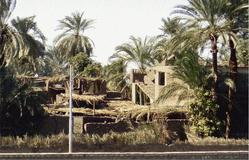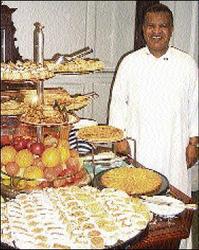Laura Tanna, Contributor

Dwellings along the Nile. - Photos by Laura Tanna
One of the best ways to visit the ancient monuments of Egypt is by taking a four- or six-day cruise on any of the more than 300 boats which travel the Nile back and forth between Luxor and Aswan. The tour starts from either city, docking at towns in-between, with a guide provided by the ship.
We choose the Oberoi Philae because of our excellent experience with the Oberoi Hotels in India and are not disappointed.
Ehab Mourad, boat executive, quietly makes sure everything runs smoothly, including three fine meals a day served in a teak-panelled dining room with oriental art and etched glass windows through which life on the Nile keeps us entranced.
The pastry chef excels. We actually request more of his delicious chocolate balls filled with chunks of fresh coconut and pistachio nuts, covered in white chocolate.
Egyptian night
But the real star of the staff is Hassan Abdo, the Nubian headwaiter from Abu Simbel. Birthday celebrations find Hassan playing a large tambourine, leading a troupe of singers in Arabic wishing the guest great happiness. On Egyptian night, everyone wears his or her galabiyyas, or long robes.
Retiring to our cabins at night, we never know what to find on our beds as room attendant Nagy Aly creates humorous crocodiles or fez-wearing sunglass-clad people out of pillows, towels and bathrobes. While we came to immerse ourselves in ancient Egyptian culture, when not doing so, we're pleasantly surprised to find life on-board the Oberoi Philae delightful.
Not only are all meals included, but, more important, groups of varying sizes are assigned a guide and transport for daily tours. Our guide, Tarak Kamel, speaks excellent English and has studied for a master's degree in Egyptology.
Our group of six, plus Takak and driver, set out twice daily in an air-conditioned van. Starting in Luxor, the temples of Karnak, Luxor, the Valleys of the Kings and Queens, Madinet Habou and the Colossi at Memnon all come within the first 24 hours - 2 p.m.-9 p.m. (because we go back for the sound and light show) and 5:45 a.m.-11:30 a.m. but the repeated introductions to the layout of temples, the meaning of certain hieroglyphics and elementary concepts of ancient Egyptian religion give us the grounding we need to grasp the enormity of what we hadn't known.
Hieroglyphic cartuches

Vulture of the Upper Nile - hieroglyphics preserved in original colour.
We start looking for hieroglyphic cartuches, tall, rectangular names of rulers, repeated for posterity. At Medinat Habu, we visit the temple of Ramses III whose military exploits are recorded on the walls, many still in the original colours of lapis lazuli, red ochre, and black preserved when Christians centuries later plastered over the offending images.
We learn that arms across the chest depict pharaohs in death, while legs forward from the side depict their actions when alive. We learn to observe the blue sky and stars painted on tomb ceilings, that the pointed tip of an obelisk is to catch the first ray of sunlight, the sun, Ra, being the source of all life. We learn to look for outstretched vulture wings symbolising Upper Egypt while the cobra symbolises Lower Egypt - together they represent a unified kingdom.
With so much to learn, I welcome leaving Luxor and while some guests sunbathe on the top deck as we travel the river, I look at life through the zoom lens of a video. Feluccas, small sailing vessels with turbaned captain in robes, looking much like temple guards, glide past. Lush palm trees line the Nile and beyond the green swaths rise desert dunes, beige sprinkled with sun-baked blackness.
Women wash clothes much as along the Rio Cobre, though many have wide, flat metal basins. Rectangular houses appear, two, three, even four storeys high, painted aqua, pink, green or left in brown brick mud with small satellite dishes atop and lines of clothes drying in the sun. Boys play soccer, occasionally cattle graze on the narrow strips of green. We encounter fishing boats, one man rowing, the other casting a net. As we pass a town minaret in the distance, a woman in black burqua strides to the riverbank and flings in a white plastic garbage bag, carried off in the river's current.
Horse-drawn carriages
When we dock at Edfu, halfway between Luxor and Aswan, horse-drawn carriages converge on the area but Oberoi no longer uses them because visitors object to the horses' poor treatment. At the Temple of Horus, we hear the story of Osiris, killed by his jealous brother Seth, Osiris' loyal wife Isis who revived him and their avenging son Horus. Buried for 2,000 years this is the best preserved Ptolemaic temple in Egypt, built beginning 237 BC.
Visitors queue to be photographed beside the giant granite statue of Horus, the falcon god at temple entrance. We now know the innermost sanctuary for the god was built first, where only priests enter. Here is the lowest ceiling, the highest floor. Successive floors are lower, ceilings higher and entry doors wider so that from the outermost courtyard where common people might glimpse in, the effect is of looking through a succession of doorways into darkness. These hieroglyphs depict a hippopotamus, the symbol of evil, being stabbed to death by Ptolemy XII.
Departing Edfu, we hear the noontime Islamic call to prayer of the muezzin. By the time we reach Kom Ombo 25 miles north of Aswan, a golden sun sets over the Nile and surrounding sugar cane and corn fields. In darkness, we walk by a bustling market to enter the temple of Kom Ombo. Constructed in the second and first centuries BC, a Graeco-Roman edifice is dedicated on one side to Horus, the falcon god, and on the other to the local crocodile god, Sobek, symbol of random evil. Hieroglyphics here actually depict a medical operation on the temple walls. We decline the opportunity to view mummified crocodiles and scurry back to the comfort of an evening of Egyptian food and music.

Headwaiter Hassan by the dessert table on the Oberoi Philae.

